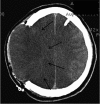Perioperative fatal embolic cerebrovascular accident after radical prostatectomy
- PMID: 20847908
- PMCID: PMC2940086
- DOI: 10.4103/2152-7806.65055
Perioperative fatal embolic cerebrovascular accident after radical prostatectomy
Abstract
Background: There is little written about the management of perioperative cerebrovascular accident (CVA). To the best of our knowledge, the present case report represents the first case in the literature of a well-documented intraoperative embolic CVA and perioperative mortality in a relatively healthy, young patient with no contributing comorbidity and no noteworthy intraoperative event.
Case description: A 53-year-old man presented for radical prostatectomy under general anesthesia. The anesthetic course and procedure were uneventful. In the postanesthesia care unit (PACU), the patient was moving all extremities but was still sedated. One hour later, he developed left hemiplegia, facial dropping, slurred speech and his head was turned to the right. The next day his mental status deteriorated, and on an emergency basis he was intubated. A CT scan of the head showed a malignant hemispheric right cerebrovascular accident with leftward midline shift. Even aggressive treatment, including a right decompressive hemicraniectomy, could not lower the high intracranial pressure, and the patient expired on the third postoperative day.
Conclusion: Guidelines for identifying and treating perioperative hemispheric CVA are urgently needed, with modification of the antiquated and useless criterion of "patient seen neurologically normal at induction time" to more useful objective criteria including "intraoperative neurophysiological recording change, gross extremity movements, facial dropping, follows simple commands" while excluding a drug-induced, sedative-influenced globally-impaired cognitive state that may last for hours.
Keywords: Cerebrovascular accident; fatal; perioperative; radical prostatectomy.
Figures




Similar articles
-
Antipsychotic Medication-Induced Hyperthermia Leading to Cerebrovascular Accident: A Case Report.Cureus. 2021 Oct 11;13(10):e18651. doi: 10.7759/cureus.18651. eCollection 2021 Oct. Cureus. 2021. PMID: 34659926 Free PMC article.
-
The Role of Intraoperative Cerebral Angiography in Transorbital Intracranial Penetrating Trauma: A Case Report and Literature Review.World Neurosurg. 2017 Jan;97:761.e5-761.e10. doi: 10.1016/j.wneu.2016.09.083. Epub 2016 Sep 28. World Neurosurg. 2017. PMID: 27693768 Review.
-
Characteristics of cerebrovascular accidents after coronary artery bypass grafting.Am Surg. 1992 Sep;58(9):584-9; discussion 589. Am Surg. 1992. PMID: 1524325
-
[A case of Creutzfeldt-Jakob disease (CJD) started with monoparesis of the left arm].Rinsho Shinkeigaku. 1996 Nov;36(11):1245-8. Rinsho Shinkeigaku. 1996. PMID: 9046857 Japanese.
-
Paraneoplastic Encephalopathy in a Patient With Metastatic Lung Cancer: A Case Study.J Adv Pract Oncol. 2018 Mar;9(2):216-221. Epub 2018 Mar 1. J Adv Pract Oncol. 2018. PMID: 30588355 Free PMC article. Review.
References
-
- Adams HP, Jr, del Zoppo G, Alberts MJ, Bhatt DL, Brass L, Furlan A, et al. Guidelines for the early management of adults with ischemic stroke: A guideline from the American heart association/American stroke association stroke council, clinical cardiology council, cardiovascular radiology and intervention council, and the atherosclerotic peripheral vascular disease and quality of care outcomes in research interdisciplinary working groups: The american academy of neurology affirms the value of this guideline as an educational tool for neurologists. Stroke. 2007;38:1655–711. - PubMed
-
- Alibhai SM, Leach M, Tomlinson G, Krahn MD, Fleshner N, Holowaty E, et al. 30-day mortality and major complications after radical prostatectomy: Influence of age and comorbidity. J Natl Cancer Inst. 2005;97:1525–32. - PubMed
-
- Heart disease and stroke statistics. 2009. Association AH.
-
- Begg CB, Riedel ER, Bach PB, Kattan MW, Schrag D, Warren JL, et al. Variations in morbidity after radical prostatectomy. N Engl J Med. 2002;346:1138–44. - PubMed
-
- Bharati S, Lev M. A personal experience with more than 6,300 congenital malformed hearts. Armonk, NY: Futura Publishing Company; 1996. The pathology of congenital heart disease.
Publication types
LinkOut - more resources
Full Text Sources

